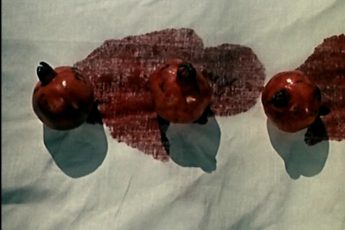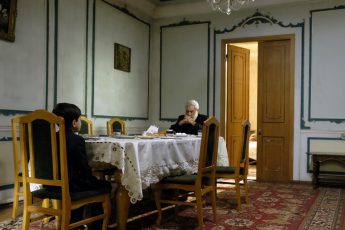
After its premiere at the Annecy Festival, Inna Sahakyan’s animated documentary Aurora’s Sunrise went on to win the Silver Apricot in the International Competition at the Golden Apricot Yerevan International Film Festival. Her vividly colored, touching film is based on the true story of Aurora (Arshaluys) Mardiganian, a survivor of the Armenian Genocide who starred in a Hollywood movie about her own traumatic experiences shortly after they happened in the early 20th century.
Aurora’s Sunrise is a stunning montage of animation, Christine Aufderhaar’s soundtrack, a voice-over, and archival material from the Oral History Archive of the Zoryan Institute. A powerful tribute to survival, the film both commemorates the horrors of genocide and paints a hopeful vision of a brighter future.
In the midst of World War I, in 1915, the Ottoman Empire began to systematically destroy its Armenian population, sending them onto death marches into the Syrian desert and killing or forcefully Islamizing women and children. This barbarous massacre cost the lives of over one million Armenians, Greeks, and Assyrians.
Sahakyan’s film follows one of the survivors, 16-year-old Aurora, the daughter of a prosperous Armenian family from Chmshgatsak. After having to watch the killing of her family, she is sent to march over 2,300 km and sold as a sex slave on the markets of Anatolia. Through Tbilisi and St. Petersburg, where she witnessed the 1917 Revolution, she managed to escape to New York City with the help of the American charity Near East Relief.
Her astonishing story, which Sahakyan’s film carefully reconstructs, does not end here. In New York, Aurora met Henry Leyford Gates, a reporter and screenwriter who immediately sees the potential of an epic blockbuster. With his help, she wrote the autobiographical book Ravished Armenia. In 1919, based on her book, Hollywood producer William Selig realized the silent film Auction of Souls, in which Aurora played herself. Celebrating enormous success, it is widely regarded to be the first film about the Armenian genocide.
Shot in an almost documentary manner, it was completed a mere four years after the massacres began in 1915 (they lasted well into 1916 and are often thought to end in 1917, though killings targeting ethnic Armenians can be dated all the way to 1923). The original footage that was included in Aurora’s Sunrise shows shocking images of persecution, mass execution, looting and death marches. The river Euphrates turns into a mass grave, with thousands of bodies floating on its ancient waters.
Auction of Souls contains one particularly graphic scene, shot in the Californian desert, of young Armenian girls being nailed to crosses by their Ottoman tormentors. This brutal crucifixion is based on Aurora’s memory, although she later reveals that they had had to tone down the violence for it to be bearable for an American audience.
Over night, Aurora became an icon of early cinema and the face of one of the biggest humanitarian campaigns in American history. The film was an international box office hit, with some of its proceeds going to orphanages in America. Despite its fame in the 1920s, the feature length Auction of Souls was mysteriously lost – and with it the memory of Aurora’s fight for justice and remembrance all but vanished.
When Aurora died in 1994, she believed Auction of Souls to have been lost forever. A few months after her death, excerpts from the film resurfaced in the Soviet Armenian National Archives, where they were filed under another name and possibly misidentified. Originally feature length, only 18 minutes of Auction of Souls have resurfaced after a tumultuous century. Only in 2022 can they be publicly accessed again.
Even in Armenia this story was relatively unknown until Sahakyan rediscovered it in 2014 to make an animated movie out of it. Through the eyes of an exceptional young girl, the viewers are taken on a gripping odyssey from the events unfolding around the Armenian Genocide all the way to Hollywood’s exploitative machinery. Throughout the film, Aurora searches for her brother who had moved to America decades before.
“When I opened the cabinet at the Zoryan Institute to find thousands of hours of interviews,” producer Vardan Hovhannisyan recalls the moment of discovery. “It was as though hundreds of butterflies spread their wings and rushed out this cabinet towards me – the butterflies of memories, the souls of these survivors.”
In Aurora’s Sunrise, survivors finally regain their voices, with their story being told through a subtle blend of different mediums, including animation and archival footage. As Sahakyan tells me, animation was used in an attempt to portray trauma while also taking some weight off the viewers by enabling an immersive experience. Sahakyan’s story is so powerful because it recreates both tragedy and moments of joy, with the sun as one hopeful leitmotif.
The playful animations are based on scenes that were shot with actors and then transposed into virtual imagery. Some of these animations are heartbreaking, some are wonderfully humorous, with an unforgettable scene of Aurora’s encounter with Charlie Chaplin at the buffet table. The 96 minutes of animation are enthralling throughout, interspersed as they are with some interviews and archival reels that are brought to life by Arpi Petrossian’s voice-over narration.
The original interviews capture an impressive woman at the end of her life. She makes us travel back in time, “getting younger and younger as she spoke,” as Sahakyan puts it. Despite her youth being robbed from her by the horrors of history, this woman refuses to be a victim. The film is driven by her courageous struggle for truth. It is a story with almost too many twists to be true, and a lasting testimony to the will of a young girl to survive.
The film is political throughout without enforcing a simple narrative; Sahakyan’s vision of tragedy is a complex, nuanced one. Her film gives as much attention to the Armenian fedayi, a group of self-organized resistance fighters, as it does to the brave Turkish shepherd who risks his life to warn Aurora’s family and ultimately helps her to escape.
One of the film’s many interesting plot lines centers around the formation of an Armenian nation state after the genocide. Today, 100 years after Armenia became one of the constituent republics of the Soviet Union, the young country still grapples for its national identity. In one of her most memorable interviews, Aurora states: “My people is my nation. If my nation is gone, no more Armenians are alive.” That Aurora’s story was forgotten until now, is one example for the long path still ahead of us in trying to make sense of the past century.




Leave a Comment